A Comprehensive Analysis of Drone Technology and Innovation
VerifiedAdded on 2020/02/24
|9
|2510
|31
Report
AI Summary
This report offers an in-depth analysis of drone technology, highlighting its evolution and impact across various sectors. It examines the major technological developments that have contributed to the success of drones, including their applications in agriculture, civil and military fields, construction, cargo systems, surveying, and scientific research. The report provides a comparative analysis of drones versus helicopters, emphasizing the former's advantages in terms of cost, safety, and operational flexibility. Furthermore, it explores the theory of innovation, specifically the diffusion of innovation, to explain the widespread adoption and success of drone technology. The report concludes by emphasizing the significance of drones in various applications and their continued potential for technological advancement and impact across many industries.
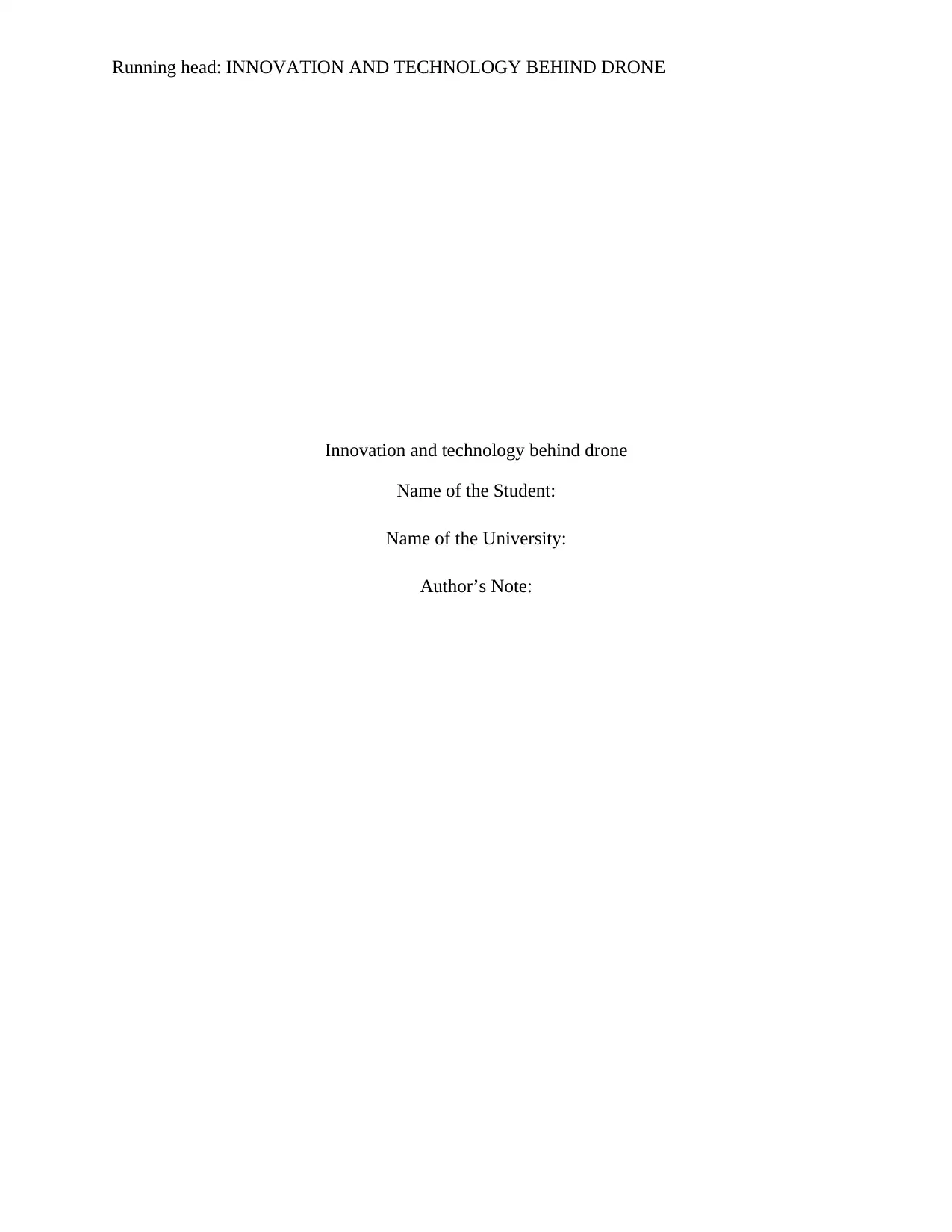
Running head: INNOVATION AND TECHNOLOGY BEHIND DRONE
Innovation and technology behind drone
Name of the Student:
Name of the University:
Author’s Note:
Innovation and technology behind drone
Name of the Student:
Name of the University:
Author’s Note:
Paraphrase This Document
Need a fresh take? Get an instant paraphrase of this document with our AI Paraphraser
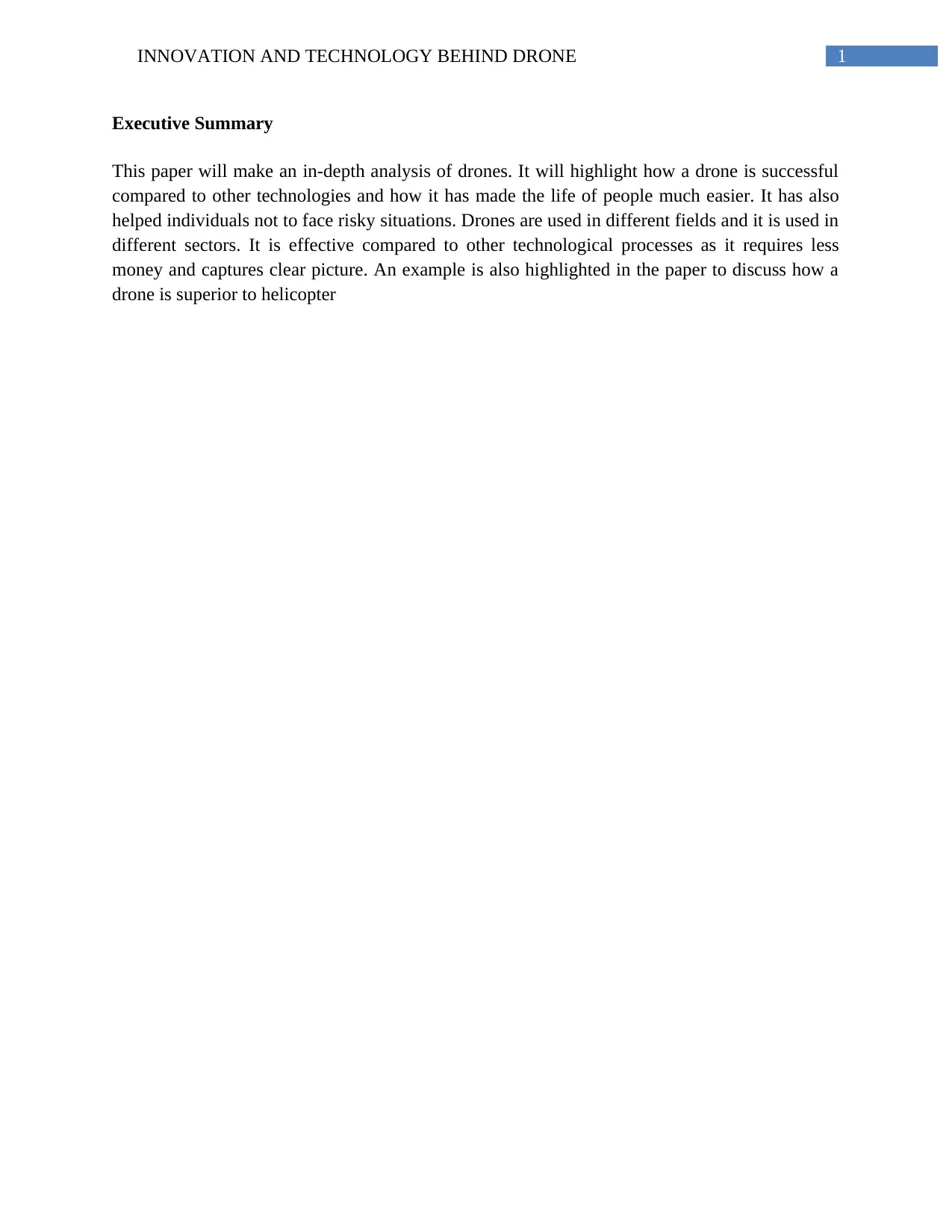
1INNOVATION AND TECHNOLOGY BEHIND DRONE
Executive Summary
This paper will make an in-depth analysis of drones. It will highlight how a drone is successful
compared to other technologies and how it has made the life of people much easier. It has also
helped individuals not to face risky situations. Drones are used in different fields and it is used in
different sectors. It is effective compared to other technological processes as it requires less
money and captures clear picture. An example is also highlighted in the paper to discuss how a
drone is superior to helicopter
Executive Summary
This paper will make an in-depth analysis of drones. It will highlight how a drone is successful
compared to other technologies and how it has made the life of people much easier. It has also
helped individuals not to face risky situations. Drones are used in different fields and it is used in
different sectors. It is effective compared to other technological processes as it requires less
money and captures clear picture. An example is also highlighted in the paper to discuss how a
drone is superior to helicopter
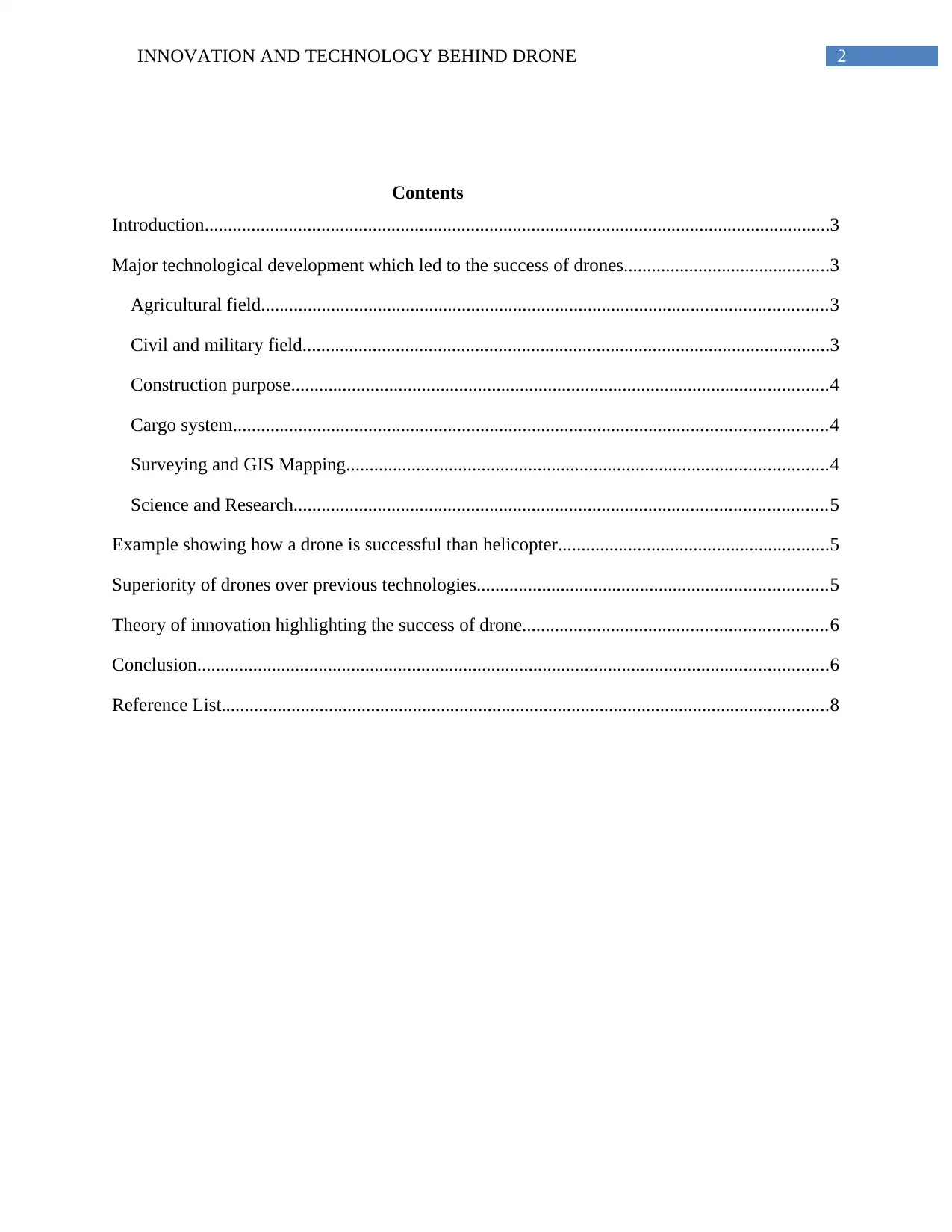
2INNOVATION AND TECHNOLOGY BEHIND DRONE
Contents
Introduction......................................................................................................................................3
Major technological development which led to the success of drones............................................3
Agricultural field.........................................................................................................................3
Civil and military field.................................................................................................................3
Construction purpose...................................................................................................................4
Cargo system...............................................................................................................................4
Surveying and GIS Mapping.......................................................................................................4
Science and Research..................................................................................................................5
Example showing how a drone is successful than helicopter..........................................................5
Superiority of drones over previous technologies...........................................................................5
Theory of innovation highlighting the success of drone.................................................................6
Conclusion.......................................................................................................................................6
Reference List..................................................................................................................................8
Contents
Introduction......................................................................................................................................3
Major technological development which led to the success of drones............................................3
Agricultural field.........................................................................................................................3
Civil and military field.................................................................................................................3
Construction purpose...................................................................................................................4
Cargo system...............................................................................................................................4
Surveying and GIS Mapping.......................................................................................................4
Science and Research..................................................................................................................5
Example showing how a drone is successful than helicopter..........................................................5
Superiority of drones over previous technologies...........................................................................5
Theory of innovation highlighting the success of drone.................................................................6
Conclusion.......................................................................................................................................6
Reference List..................................................................................................................................8
⊘ This is a preview!⊘
Do you want full access?
Subscribe today to unlock all pages.

Trusted by 1+ million students worldwide
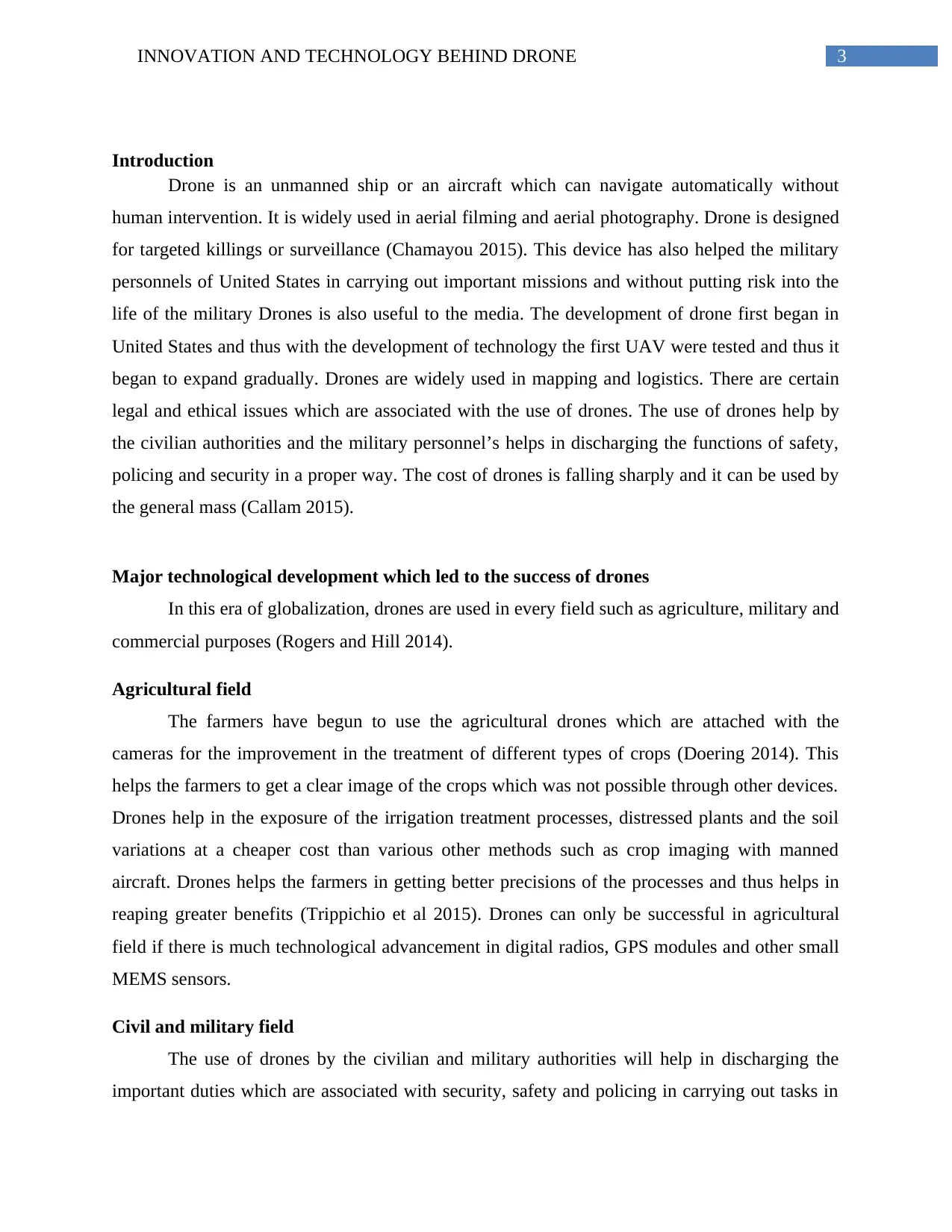
3INNOVATION AND TECHNOLOGY BEHIND DRONE
Introduction
Drone is an unmanned ship or an aircraft which can navigate automatically without
human intervention. It is widely used in aerial filming and aerial photography. Drone is designed
for targeted killings or surveillance (Chamayou 2015). This device has also helped the military
personnels of United States in carrying out important missions and without putting risk into the
life of the military Drones is also useful to the media. The development of drone first began in
United States and thus with the development of technology the first UAV were tested and thus it
began to expand gradually. Drones are widely used in mapping and logistics. There are certain
legal and ethical issues which are associated with the use of drones. The use of drones help by
the civilian authorities and the military personnel’s helps in discharging the functions of safety,
policing and security in a proper way. The cost of drones is falling sharply and it can be used by
the general mass (Callam 2015).
Major technological development which led to the success of drones
In this era of globalization, drones are used in every field such as agriculture, military and
commercial purposes (Rogers and Hill 2014).
Agricultural field
The farmers have begun to use the agricultural drones which are attached with the
cameras for the improvement in the treatment of different types of crops (Doering 2014). This
helps the farmers to get a clear image of the crops which was not possible through other devices.
Drones help in the exposure of the irrigation treatment processes, distressed plants and the soil
variations at a cheaper cost than various other methods such as crop imaging with manned
aircraft. Drones helps the farmers in getting better precisions of the processes and thus helps in
reaping greater benefits (Trippichio et al 2015). Drones can only be successful in agricultural
field if there is much technological advancement in digital radios, GPS modules and other small
MEMS sensors.
Civil and military field
The use of drones by the civilian and military authorities will help in discharging the
important duties which are associated with security, safety and policing in carrying out tasks in
Introduction
Drone is an unmanned ship or an aircraft which can navigate automatically without
human intervention. It is widely used in aerial filming and aerial photography. Drone is designed
for targeted killings or surveillance (Chamayou 2015). This device has also helped the military
personnels of United States in carrying out important missions and without putting risk into the
life of the military Drones is also useful to the media. The development of drone first began in
United States and thus with the development of technology the first UAV were tested and thus it
began to expand gradually. Drones are widely used in mapping and logistics. There are certain
legal and ethical issues which are associated with the use of drones. The use of drones help by
the civilian authorities and the military personnel’s helps in discharging the functions of safety,
policing and security in a proper way. The cost of drones is falling sharply and it can be used by
the general mass (Callam 2015).
Major technological development which led to the success of drones
In this era of globalization, drones are used in every field such as agriculture, military and
commercial purposes (Rogers and Hill 2014).
Agricultural field
The farmers have begun to use the agricultural drones which are attached with the
cameras for the improvement in the treatment of different types of crops (Doering 2014). This
helps the farmers to get a clear image of the crops which was not possible through other devices.
Drones help in the exposure of the irrigation treatment processes, distressed plants and the soil
variations at a cheaper cost than various other methods such as crop imaging with manned
aircraft. Drones helps the farmers in getting better precisions of the processes and thus helps in
reaping greater benefits (Trippichio et al 2015). Drones can only be successful in agricultural
field if there is much technological advancement in digital radios, GPS modules and other small
MEMS sensors.
Civil and military field
The use of drones by the civilian and military authorities will help in discharging the
important duties which are associated with security, safety and policing in carrying out tasks in
Paraphrase This Document
Need a fresh take? Get an instant paraphrase of this document with our AI Paraphraser
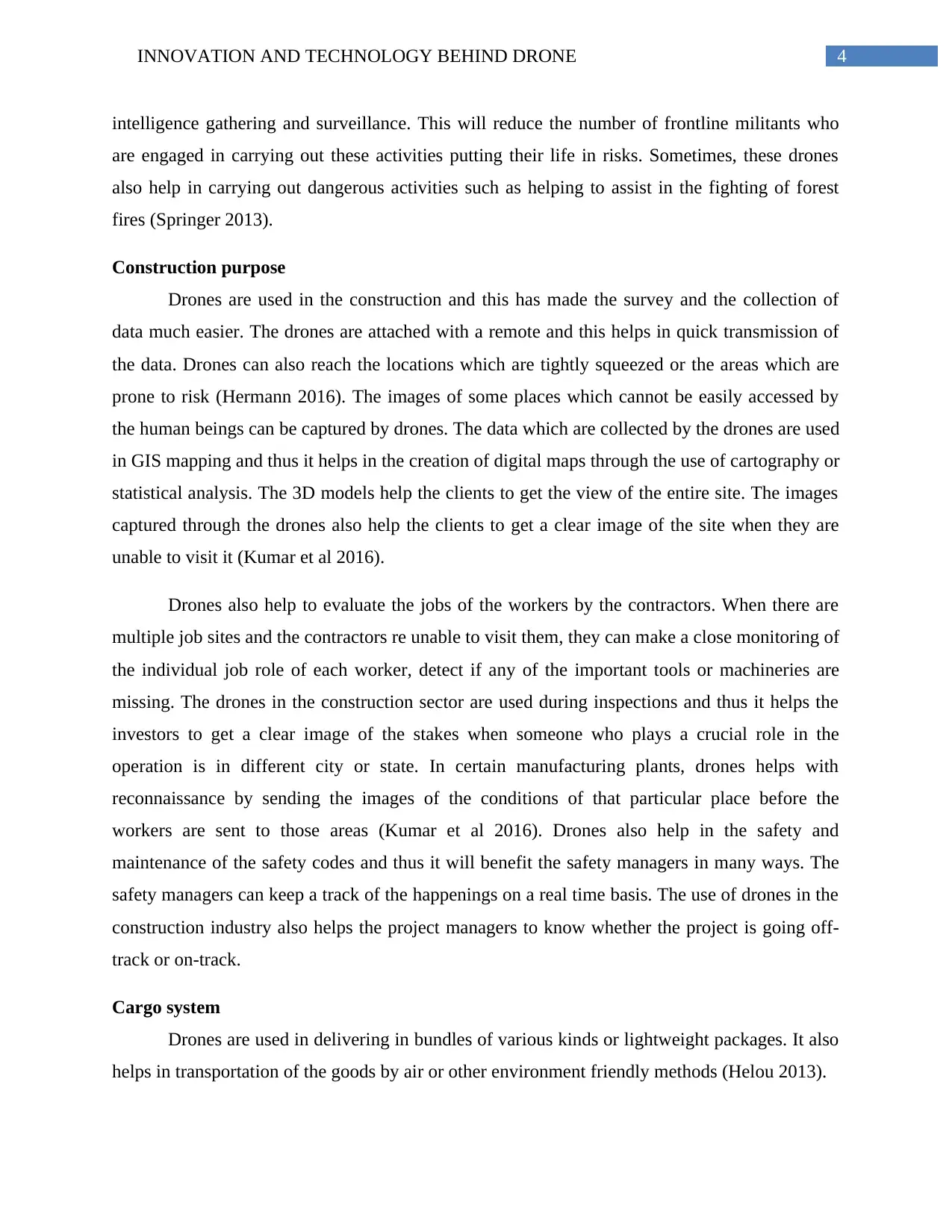
4INNOVATION AND TECHNOLOGY BEHIND DRONE
intelligence gathering and surveillance. This will reduce the number of frontline militants who
are engaged in carrying out these activities putting their life in risks. Sometimes, these drones
also help in carrying out dangerous activities such as helping to assist in the fighting of forest
fires (Springer 2013).
Construction purpose
Drones are used in the construction and this has made the survey and the collection of
data much easier. The drones are attached with a remote and this helps in quick transmission of
the data. Drones can also reach the locations which are tightly squeezed or the areas which are
prone to risk (Hermann 2016). The images of some places which cannot be easily accessed by
the human beings can be captured by drones. The data which are collected by the drones are used
in GIS mapping and thus it helps in the creation of digital maps through the use of cartography or
statistical analysis. The 3D models help the clients to get the view of the entire site. The images
captured through the drones also help the clients to get a clear image of the site when they are
unable to visit it (Kumar et al 2016).
Drones also help to evaluate the jobs of the workers by the contractors. When there are
multiple job sites and the contractors re unable to visit them, they can make a close monitoring of
the individual job role of each worker, detect if any of the important tools or machineries are
missing. The drones in the construction sector are used during inspections and thus it helps the
investors to get a clear image of the stakes when someone who plays a crucial role in the
operation is in different city or state. In certain manufacturing plants, drones helps with
reconnaissance by sending the images of the conditions of that particular place before the
workers are sent to those areas (Kumar et al 2016). Drones also help in the safety and
maintenance of the safety codes and thus it will benefit the safety managers in many ways. The
safety managers can keep a track of the happenings on a real time basis. The use of drones in the
construction industry also helps the project managers to know whether the project is going off-
track or on-track.
Cargo system
Drones are used in delivering in bundles of various kinds or lightweight packages. It also
helps in transportation of the goods by air or other environment friendly methods (Helou 2013).
intelligence gathering and surveillance. This will reduce the number of frontline militants who
are engaged in carrying out these activities putting their life in risks. Sometimes, these drones
also help in carrying out dangerous activities such as helping to assist in the fighting of forest
fires (Springer 2013).
Construction purpose
Drones are used in the construction and this has made the survey and the collection of
data much easier. The drones are attached with a remote and this helps in quick transmission of
the data. Drones can also reach the locations which are tightly squeezed or the areas which are
prone to risk (Hermann 2016). The images of some places which cannot be easily accessed by
the human beings can be captured by drones. The data which are collected by the drones are used
in GIS mapping and thus it helps in the creation of digital maps through the use of cartography or
statistical analysis. The 3D models help the clients to get the view of the entire site. The images
captured through the drones also help the clients to get a clear image of the site when they are
unable to visit it (Kumar et al 2016).
Drones also help to evaluate the jobs of the workers by the contractors. When there are
multiple job sites and the contractors re unable to visit them, they can make a close monitoring of
the individual job role of each worker, detect if any of the important tools or machineries are
missing. The drones in the construction sector are used during inspections and thus it helps the
investors to get a clear image of the stakes when someone who plays a crucial role in the
operation is in different city or state. In certain manufacturing plants, drones helps with
reconnaissance by sending the images of the conditions of that particular place before the
workers are sent to those areas (Kumar et al 2016). Drones also help in the safety and
maintenance of the safety codes and thus it will benefit the safety managers in many ways. The
safety managers can keep a track of the happenings on a real time basis. The use of drones in the
construction industry also helps the project managers to know whether the project is going off-
track or on-track.
Cargo system
Drones are used in delivering in bundles of various kinds or lightweight packages. It also
helps in transportation of the goods by air or other environment friendly methods (Helou 2013).
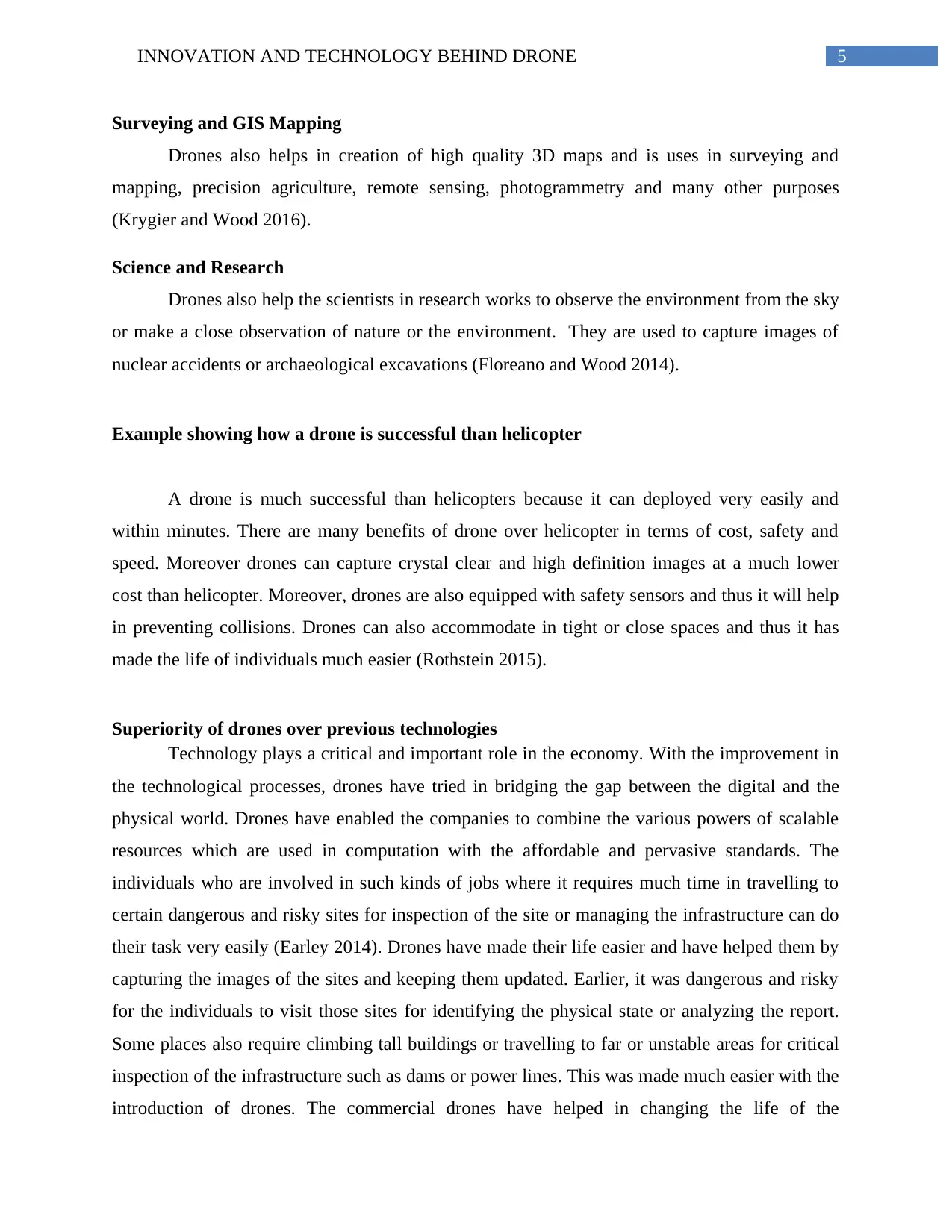
5INNOVATION AND TECHNOLOGY BEHIND DRONE
Surveying and GIS Mapping
Drones also helps in creation of high quality 3D maps and is uses in surveying and
mapping, precision agriculture, remote sensing, photogrammetry and many other purposes
(Krygier and Wood 2016).
Science and Research
Drones also help the scientists in research works to observe the environment from the sky
or make a close observation of nature or the environment. They are used to capture images of
nuclear accidents or archaeological excavations (Floreano and Wood 2014).
Example showing how a drone is successful than helicopter
A drone is much successful than helicopters because it can deployed very easily and
within minutes. There are many benefits of drone over helicopter in terms of cost, safety and
speed. Moreover drones can capture crystal clear and high definition images at a much lower
cost than helicopter. Moreover, drones are also equipped with safety sensors and thus it will help
in preventing collisions. Drones can also accommodate in tight or close spaces and thus it has
made the life of individuals much easier (Rothstein 2015).
Superiority of drones over previous technologies
Technology plays a critical and important role in the economy. With the improvement in
the technological processes, drones have tried in bridging the gap between the digital and the
physical world. Drones have enabled the companies to combine the various powers of scalable
resources which are used in computation with the affordable and pervasive standards. The
individuals who are involved in such kinds of jobs where it requires much time in travelling to
certain dangerous and risky sites for inspection of the site or managing the infrastructure can do
their task very easily (Earley 2014). Drones have made their life easier and have helped them by
capturing the images of the sites and keeping them updated. Earlier, it was dangerous and risky
for the individuals to visit those sites for identifying the physical state or analyzing the report.
Some places also require climbing tall buildings or travelling to far or unstable areas for critical
inspection of the infrastructure such as dams or power lines. This was made much easier with the
introduction of drones. The commercial drones have helped in changing the life of the
Surveying and GIS Mapping
Drones also helps in creation of high quality 3D maps and is uses in surveying and
mapping, precision agriculture, remote sensing, photogrammetry and many other purposes
(Krygier and Wood 2016).
Science and Research
Drones also help the scientists in research works to observe the environment from the sky
or make a close observation of nature or the environment. They are used to capture images of
nuclear accidents or archaeological excavations (Floreano and Wood 2014).
Example showing how a drone is successful than helicopter
A drone is much successful than helicopters because it can deployed very easily and
within minutes. There are many benefits of drone over helicopter in terms of cost, safety and
speed. Moreover drones can capture crystal clear and high definition images at a much lower
cost than helicopter. Moreover, drones are also equipped with safety sensors and thus it will help
in preventing collisions. Drones can also accommodate in tight or close spaces and thus it has
made the life of individuals much easier (Rothstein 2015).
Superiority of drones over previous technologies
Technology plays a critical and important role in the economy. With the improvement in
the technological processes, drones have tried in bridging the gap between the digital and the
physical world. Drones have enabled the companies to combine the various powers of scalable
resources which are used in computation with the affordable and pervasive standards. The
individuals who are involved in such kinds of jobs where it requires much time in travelling to
certain dangerous and risky sites for inspection of the site or managing the infrastructure can do
their task very easily (Earley 2014). Drones have made their life easier and have helped them by
capturing the images of the sites and keeping them updated. Earlier, it was dangerous and risky
for the individuals to visit those sites for identifying the physical state or analyzing the report.
Some places also require climbing tall buildings or travelling to far or unstable areas for critical
inspection of the infrastructure such as dams or power lines. This was made much easier with the
introduction of drones. The commercial drones have helped in changing the life of the
⊘ This is a preview!⊘
Do you want full access?
Subscribe today to unlock all pages.

Trusted by 1+ million students worldwide
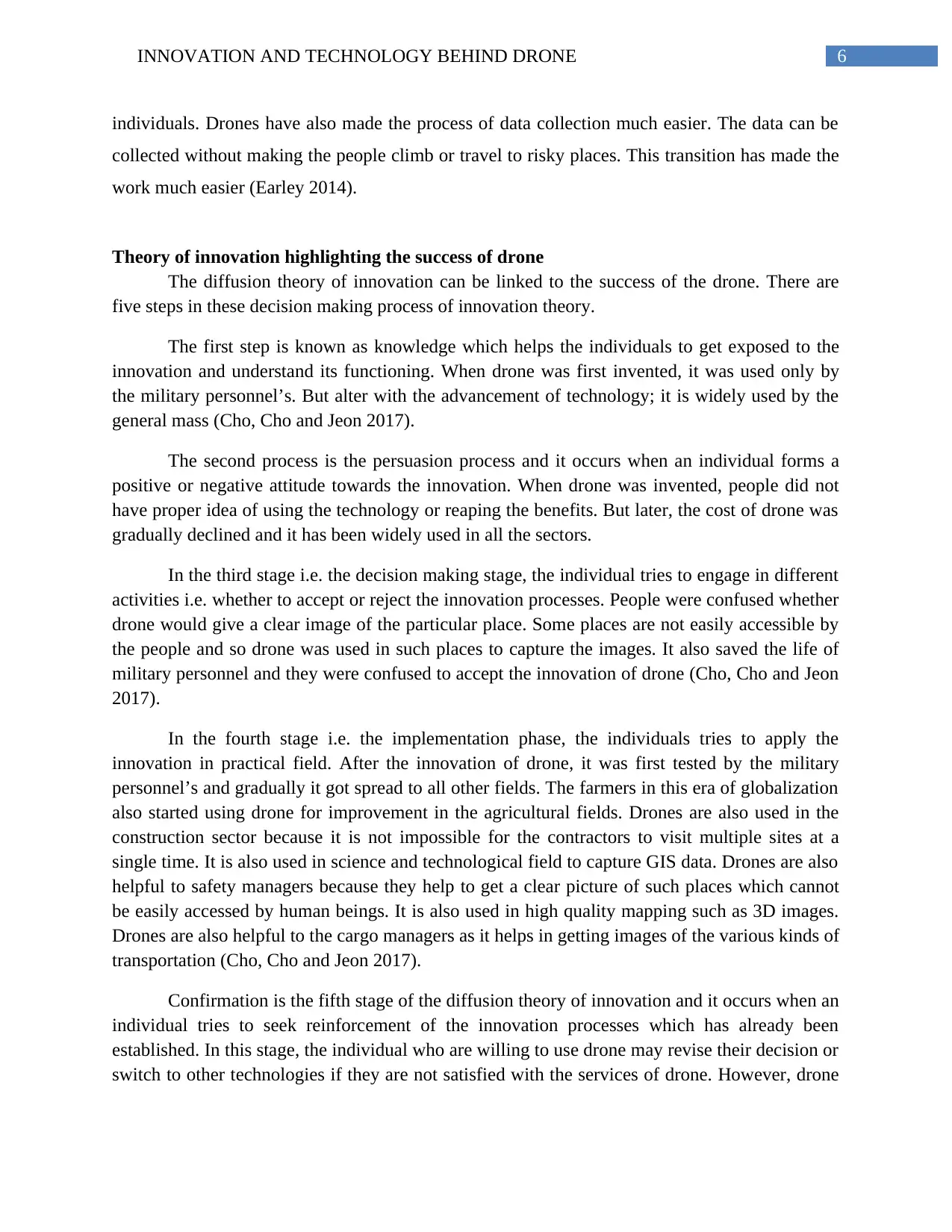
6INNOVATION AND TECHNOLOGY BEHIND DRONE
individuals. Drones have also made the process of data collection much easier. The data can be
collected without making the people climb or travel to risky places. This transition has made the
work much easier (Earley 2014).
Theory of innovation highlighting the success of drone
The diffusion theory of innovation can be linked to the success of the drone. There are
five steps in these decision making process of innovation theory.
The first step is known as knowledge which helps the individuals to get exposed to the
innovation and understand its functioning. When drone was first invented, it was used only by
the military personnel’s. But alter with the advancement of technology; it is widely used by the
general mass (Cho, Cho and Jeon 2017).
The second process is the persuasion process and it occurs when an individual forms a
positive or negative attitude towards the innovation. When drone was invented, people did not
have proper idea of using the technology or reaping the benefits. But later, the cost of drone was
gradually declined and it has been widely used in all the sectors.
In the third stage i.e. the decision making stage, the individual tries to engage in different
activities i.e. whether to accept or reject the innovation processes. People were confused whether
drone would give a clear image of the particular place. Some places are not easily accessible by
the people and so drone was used in such places to capture the images. It also saved the life of
military personnel and they were confused to accept the innovation of drone (Cho, Cho and Jeon
2017).
In the fourth stage i.e. the implementation phase, the individuals tries to apply the
innovation in practical field. After the innovation of drone, it was first tested by the military
personnel’s and gradually it got spread to all other fields. The farmers in this era of globalization
also started using drone for improvement in the agricultural fields. Drones are also used in the
construction sector because it is not impossible for the contractors to visit multiple sites at a
single time. It is also used in science and technological field to capture GIS data. Drones are also
helpful to safety managers because they help to get a clear picture of such places which cannot
be easily accessed by human beings. It is also used in high quality mapping such as 3D images.
Drones are also helpful to the cargo managers as it helps in getting images of the various kinds of
transportation (Cho, Cho and Jeon 2017).
Confirmation is the fifth stage of the diffusion theory of innovation and it occurs when an
individual tries to seek reinforcement of the innovation processes which has already been
established. In this stage, the individual who are willing to use drone may revise their decision or
switch to other technologies if they are not satisfied with the services of drone. However, drone
individuals. Drones have also made the process of data collection much easier. The data can be
collected without making the people climb or travel to risky places. This transition has made the
work much easier (Earley 2014).
Theory of innovation highlighting the success of drone
The diffusion theory of innovation can be linked to the success of the drone. There are
five steps in these decision making process of innovation theory.
The first step is known as knowledge which helps the individuals to get exposed to the
innovation and understand its functioning. When drone was first invented, it was used only by
the military personnel’s. But alter with the advancement of technology; it is widely used by the
general mass (Cho, Cho and Jeon 2017).
The second process is the persuasion process and it occurs when an individual forms a
positive or negative attitude towards the innovation. When drone was invented, people did not
have proper idea of using the technology or reaping the benefits. But later, the cost of drone was
gradually declined and it has been widely used in all the sectors.
In the third stage i.e. the decision making stage, the individual tries to engage in different
activities i.e. whether to accept or reject the innovation processes. People were confused whether
drone would give a clear image of the particular place. Some places are not easily accessible by
the people and so drone was used in such places to capture the images. It also saved the life of
military personnel and they were confused to accept the innovation of drone (Cho, Cho and Jeon
2017).
In the fourth stage i.e. the implementation phase, the individuals tries to apply the
innovation in practical field. After the innovation of drone, it was first tested by the military
personnel’s and gradually it got spread to all other fields. The farmers in this era of globalization
also started using drone for improvement in the agricultural fields. Drones are also used in the
construction sector because it is not impossible for the contractors to visit multiple sites at a
single time. It is also used in science and technological field to capture GIS data. Drones are also
helpful to safety managers because they help to get a clear picture of such places which cannot
be easily accessed by human beings. It is also used in high quality mapping such as 3D images.
Drones are also helpful to the cargo managers as it helps in getting images of the various kinds of
transportation (Cho, Cho and Jeon 2017).
Confirmation is the fifth stage of the diffusion theory of innovation and it occurs when an
individual tries to seek reinforcement of the innovation processes which has already been
established. In this stage, the individual who are willing to use drone may revise their decision or
switch to other technologies if they are not satisfied with the services of drone. However, drone
Paraphrase This Document
Need a fresh take? Get an instant paraphrase of this document with our AI Paraphraser
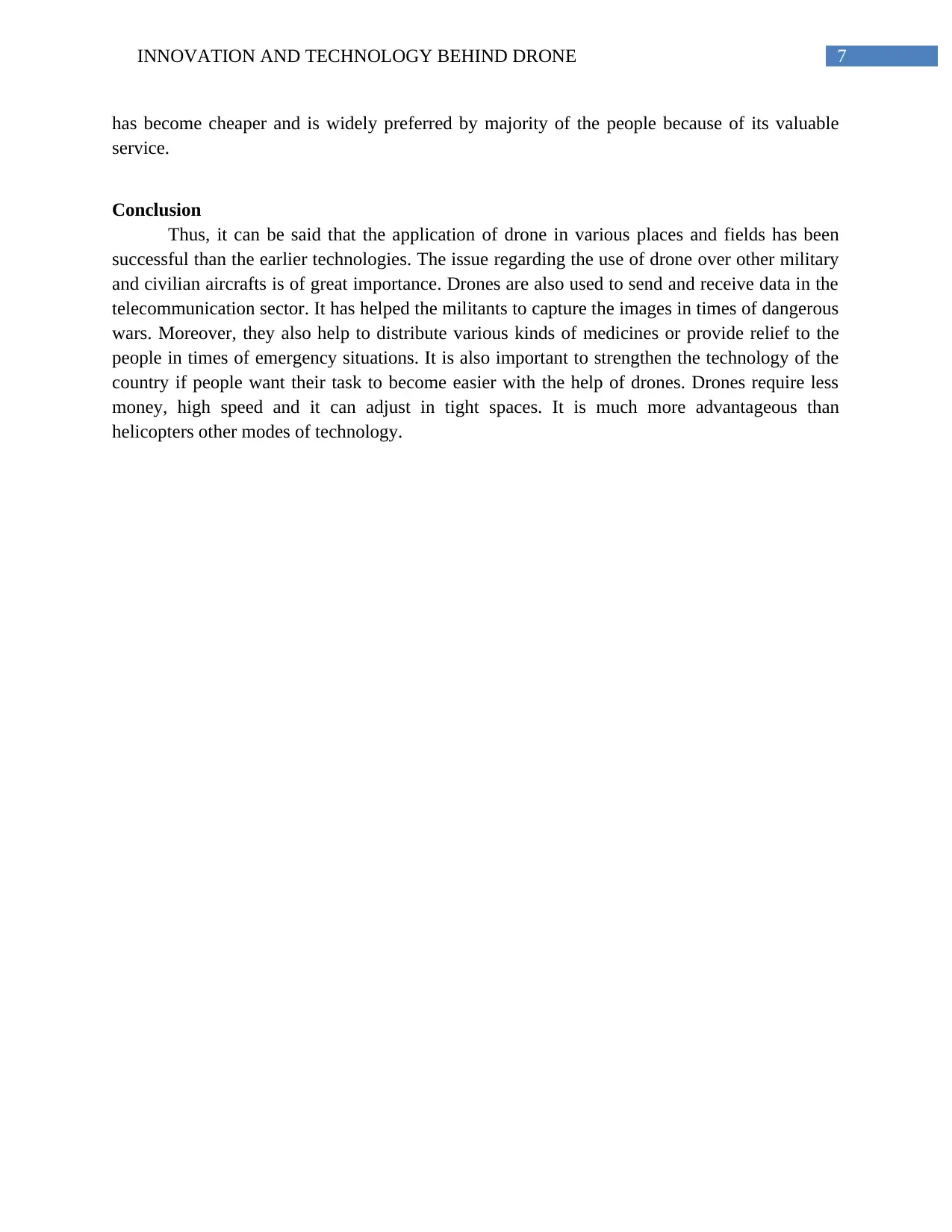
7INNOVATION AND TECHNOLOGY BEHIND DRONE
has become cheaper and is widely preferred by majority of the people because of its valuable
service.
Conclusion
Thus, it can be said that the application of drone in various places and fields has been
successful than the earlier technologies. The issue regarding the use of drone over other military
and civilian aircrafts is of great importance. Drones are also used to send and receive data in the
telecommunication sector. It has helped the militants to capture the images in times of dangerous
wars. Moreover, they also help to distribute various kinds of medicines or provide relief to the
people in times of emergency situations. It is also important to strengthen the technology of the
country if people want their task to become easier with the help of drones. Drones require less
money, high speed and it can adjust in tight spaces. It is much more advantageous than
helicopters other modes of technology.
has become cheaper and is widely preferred by majority of the people because of its valuable
service.
Conclusion
Thus, it can be said that the application of drone in various places and fields has been
successful than the earlier technologies. The issue regarding the use of drone over other military
and civilian aircrafts is of great importance. Drones are also used to send and receive data in the
telecommunication sector. It has helped the militants to capture the images in times of dangerous
wars. Moreover, they also help to distribute various kinds of medicines or provide relief to the
people in times of emergency situations. It is also important to strengthen the technology of the
country if people want their task to become easier with the help of drones. Drones require less
money, high speed and it can adjust in tight spaces. It is much more advantageous than
helicopters other modes of technology.
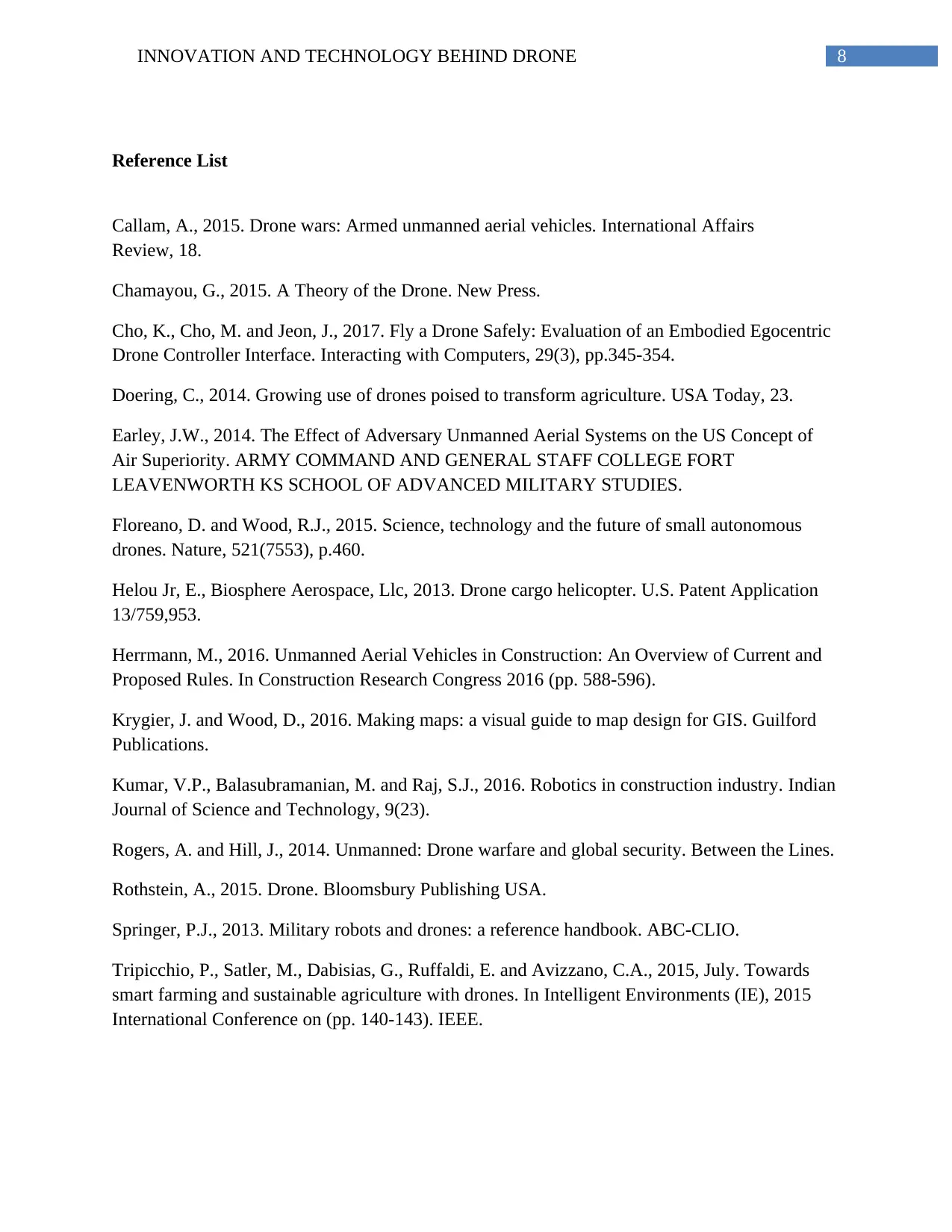
8INNOVATION AND TECHNOLOGY BEHIND DRONE
Reference List
Callam, A., 2015. Drone wars: Armed unmanned aerial vehicles. International Affairs
Review, 18.
Chamayou, G., 2015. A Theory of the Drone. New Press.
Cho, K., Cho, M. and Jeon, J., 2017. Fly a Drone Safely: Evaluation of an Embodied Egocentric
Drone Controller Interface. Interacting with Computers, 29(3), pp.345-354.
Doering, C., 2014. Growing use of drones poised to transform agriculture. USA Today, 23.
Earley, J.W., 2014. The Effect of Adversary Unmanned Aerial Systems on the US Concept of
Air Superiority. ARMY COMMAND AND GENERAL STAFF COLLEGE FORT
LEAVENWORTH KS SCHOOL OF ADVANCED MILITARY STUDIES.
Floreano, D. and Wood, R.J., 2015. Science, technology and the future of small autonomous
drones. Nature, 521(7553), p.460.
Helou Jr, E., Biosphere Aerospace, Llc, 2013. Drone cargo helicopter. U.S. Patent Application
13/759,953.
Herrmann, M., 2016. Unmanned Aerial Vehicles in Construction: An Overview of Current and
Proposed Rules. In Construction Research Congress 2016 (pp. 588-596).
Krygier, J. and Wood, D., 2016. Making maps: a visual guide to map design for GIS. Guilford
Publications.
Kumar, V.P., Balasubramanian, M. and Raj, S.J., 2016. Robotics in construction industry. Indian
Journal of Science and Technology, 9(23).
Rogers, A. and Hill, J., 2014. Unmanned: Drone warfare and global security. Between the Lines.
Rothstein, A., 2015. Drone. Bloomsbury Publishing USA.
Springer, P.J., 2013. Military robots and drones: a reference handbook. ABC-CLIO.
Tripicchio, P., Satler, M., Dabisias, G., Ruffaldi, E. and Avizzano, C.A., 2015, July. Towards
smart farming and sustainable agriculture with drones. In Intelligent Environments (IE), 2015
International Conference on (pp. 140-143). IEEE.
Reference List
Callam, A., 2015. Drone wars: Armed unmanned aerial vehicles. International Affairs
Review, 18.
Chamayou, G., 2015. A Theory of the Drone. New Press.
Cho, K., Cho, M. and Jeon, J., 2017. Fly a Drone Safely: Evaluation of an Embodied Egocentric
Drone Controller Interface. Interacting with Computers, 29(3), pp.345-354.
Doering, C., 2014. Growing use of drones poised to transform agriculture. USA Today, 23.
Earley, J.W., 2014. The Effect of Adversary Unmanned Aerial Systems on the US Concept of
Air Superiority. ARMY COMMAND AND GENERAL STAFF COLLEGE FORT
LEAVENWORTH KS SCHOOL OF ADVANCED MILITARY STUDIES.
Floreano, D. and Wood, R.J., 2015. Science, technology and the future of small autonomous
drones. Nature, 521(7553), p.460.
Helou Jr, E., Biosphere Aerospace, Llc, 2013. Drone cargo helicopter. U.S. Patent Application
13/759,953.
Herrmann, M., 2016. Unmanned Aerial Vehicles in Construction: An Overview of Current and
Proposed Rules. In Construction Research Congress 2016 (pp. 588-596).
Krygier, J. and Wood, D., 2016. Making maps: a visual guide to map design for GIS. Guilford
Publications.
Kumar, V.P., Balasubramanian, M. and Raj, S.J., 2016. Robotics in construction industry. Indian
Journal of Science and Technology, 9(23).
Rogers, A. and Hill, J., 2014. Unmanned: Drone warfare and global security. Between the Lines.
Rothstein, A., 2015. Drone. Bloomsbury Publishing USA.
Springer, P.J., 2013. Military robots and drones: a reference handbook. ABC-CLIO.
Tripicchio, P., Satler, M., Dabisias, G., Ruffaldi, E. and Avizzano, C.A., 2015, July. Towards
smart farming and sustainable agriculture with drones. In Intelligent Environments (IE), 2015
International Conference on (pp. 140-143). IEEE.
⊘ This is a preview!⊘
Do you want full access?
Subscribe today to unlock all pages.

Trusted by 1+ million students worldwide
1 out of 9
Your All-in-One AI-Powered Toolkit for Academic Success.
+13062052269
info@desklib.com
Available 24*7 on WhatsApp / Email
![[object Object]](/_next/static/media/star-bottom.7253800d.svg)
Unlock your academic potential
Copyright © 2020–2025 A2Z Services. All Rights Reserved. Developed and managed by ZUCOL.


